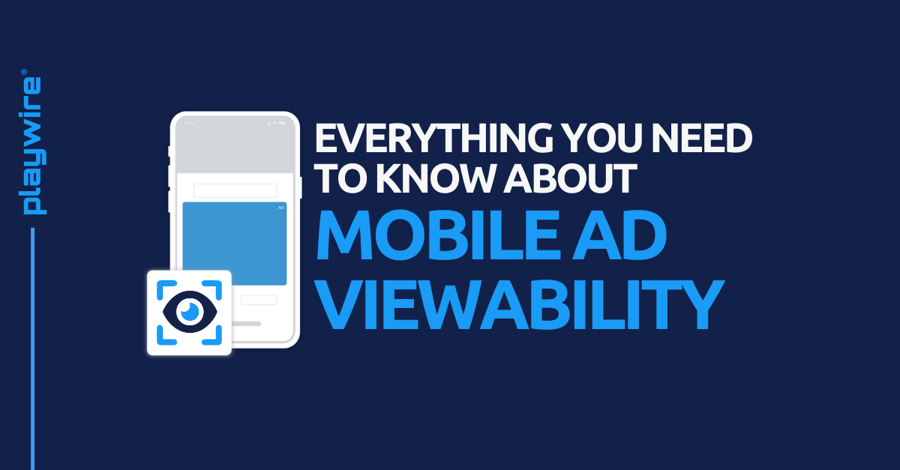Everything You Need to Know About Mobile Ad Viewability
May 30, 2023
Editorial Policy
All of our content is generated by subject matter experts with years of ad tech experience and structured by writers and educators for ease of use and digestibility. Learn more about our rigorous interview, content production and review process here.

Key Points
- Mobile ad viewability rating is the measurement of ad impressions that were seen by mobile users. It’s a key metric used by both publishers and advertisers to assess the value of mobile ad inventory.
- Similar to web viewability in most ways, the main differences between desktop and mobile ad viewability are the environment and the challenges when it comes to optimizing.
- Just like web viewability, improving mobile app viewability requires a delicate balance between ad revenue and viewable ad placements. It’s easy to make mistakes when optimizing viewability, which is why many developers turn to a revenue partner like Playwire for help.
Mobile ad viewability and desktop or web ad viewability are siblings, not twins. Think Sansa and Arya.
They share similarities like family history and culture. And they both want the same thing: to protect Winterfell. But the ways each goes about accomplishing that goal are…a bit different.

The same goes for viewability across publishing formats. While web and app viewability are both primary metrics for assessing the value of ad inventory, differences present themselves when you compare optimizing inside each environment side-by-side.
There are plenty of differences to consider.
That’s why, as a mobile publisher or app developer, it’s important to understand mobile ad viewability and the unique factors that you’ll need to navigate. Otherwise, you’ll have no chance.
It wouldn’t be nice to call mobile viewability the rebellious sibling, but it would be apt. Understanding the metric in this format is difficult. So, in this article, we’ll give you all the info you need to overcome the hurdles.
Read the Complete Guide to Ad Viewability For Publishers
What is Mobile Ad Viewability?
In terms of definition, mobile ad viewability is identical to web: both are metrics for assessing the value of ad inventory.
Mobile ad viewability is determined in compliance with the IAB and MRC’s guidelines for viewability and presented as a rate or percentage.
To qualify as a viewable impression, it must be at least 50% visible on the screen. Display ads must stay 50% visible for at least one second. For video ads, two seconds.
Mobile viewability shows both publishers and advertisers the likelihood that an ad placed on a mobile platform will be viewed by a user.
If ads are viewable, that means users can engage with them, click them, and complete a purchase.
So, high ad viewability = good.
Low ad viewability =
… you get it.
How to Measure Mobile Ad Viewability
Historically, mobile app publishers and app developers have had a challenging time getting an accurate ad viewability score.
However, modern tech advancements have made measuring mobile app content and ad viewability easier… if you know what you’re doing.
First, some key definitions —
- Served ad: Also referred to as an ad call or ad request, this is an ad that was delivered to the user. It may or may not be considered viewable.
- Viewable ad: This is a served ad that met the criteria for viewable. It may or may not be viewed by the user during that session, depending on their behavior.
- Software Development Kit (SDK): Measuring mobile ad viewability requires a third-party SDK. Aside from Active View, which is native to AdMob, Google recommends the IAB’s open-source code, called Open Measurement.
Challenges With Measuring Mobile Ad Viewability
The biggest challenge when trying to measure viewability in-app vs. on a web page is the difference in environments.
Think of your big brother, who left home straight after graduation to move to a new city.
To start, mobile offers much less real estate for ads. It’s like a tiny bachelor pad vs. your parents’ detached bungalow in the suburbs. With mobile advertising, there’s just less room for viewable placements.
Then there’s the difference between cursers and fingers as navigational tools. Cars vs. the subway. In a car, you can go from your bungalow directly to the grocery store. On the subway, you’ll get to the grocery store… after making 17 unnecessary stops along the way.
When users use their fingers to click things, they tend to be less precise. This leads to all sorts of messiness — accidental clicks and increased bounce rates.
All these challenges mean mobile publishers need to be more thoughtful about in-app ad placement. More room between content and ads, ads designed to accommodate an already smaller screen size, etc, etc.
It also explains why your brother replaced his bed and couch with a futon. Less space requires more creativity.
Learn more about optimizing your ad layout in both mobile and web environments with our best practices for ad unit performance.
-- Article Continues Below --
Check out our Complete Ad Viewability Resource Center!
How to Improve Ad Viewability in Mobile Apps
Improving viewability in-app isn’t much different from web in terms of strategy.
That being said, there are a few things to remember —
- Page load speed: This is an especially important metric for mobile apps since mobile users tend to have even less patience than desktop users. Even a one-second delay can be devastating for your KPIs.
- Design: Consider important content and how certain ad placements could damage user experience. In mobile apps, this means considering ad density and avoiding ad clutter at all costs. For websites, this means prioritizing mobile layout optimization.
- Ad placement: this is one area where mobile and web vary significantly. While placing ads near the top of the page is a best practice for desktop viewability, mobile users tend to scroll past these ads. This means middle-screen placements perform best on mobile.
Improve Mobile Viewability With Playwire
Despite the noted differences, there are plenty of similarities between mobile and web ad viewability. The main similarity is how difficult it is to optimize.
There’s a delicate balance that must be struck. It’s easy to get tripped up and make costly mistakes along the way.
But there’s good news — if you want to get serious about improving mobile ad viewability without all the sibling rivalry, then you’re in the right place.
At Playwire, we’ve got the tools, tech, and expert team members to help you reach your ad monetization goals. Plus, our dedicated support teams will treat you like family.
Ready to get started? Contact us online today.

-1.png?width=800&height=157&name=1-playwire-logo-primary-2021%20(1)-1.png)





